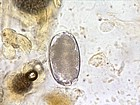Difference between revisions of "Category:Horse Nematodes"
Jump to navigation
Jump to search
| Line 1: | Line 1: | ||
== Gastrointestinal Nematodes == | == Gastrointestinal Nematodes == | ||
==== Introduction ==== | ==== Introduction ==== | ||
| − | + | ||
| − | |||
| − | |||
| − | |||
[[Image:Strongylus.jpg|thumb|right|150px|''Strongylus'' - Joaquim Castellà Veterinary Parasitology Universitat Autònoma de Barcelona]] | [[Image:Strongylus.jpg|thumb|right|150px|''Strongylus'' - Joaquim Castellà Veterinary Parasitology Universitat Autònoma de Barcelona]] | ||
Many nematode species occur in the equine gastrointestinal tract, although not all are of equal importance: | Many nematode species occur in the equine gastrointestinal tract, although not all are of equal importance: | ||
| Line 20: | Line 17: | ||
*''Trichostrongylus axei'' | *''Trichostrongylus axei'' | ||
| | | | ||
| − | *''Parascaris'' | + | *''[[Parascaris equorum]]'' |
*''[[Strongyloides]]'' | *''[[Strongyloides]]'' | ||
Revision as of 22:06, 26 April 2010
Gastrointestinal Nematodes
Introduction
Many nematode species occur in the equine gastrointestinal tract, although not all are of equal importance:
| Stomach | Small Intestine | Large Intestine |
|---|---|---|
|
|
Strongyles (Red worms)
The strongyles that occur in the horse can be divided on the basis of size into two groups
- Large strongyles
- Strongylus species (3 species; used to be widespread prior to the introduction of worm control programmes; now uncommon)
- Triodontophorus species (common)
- Small strongyles
- Also known as Cyathostomins (preferred term), cyathostomes, trichonemes or small redworms
- Cyathostomins (widespread, including 4 genera and over 40 species of worms)
Pages in category "Horse Nematodes"
The following 16 pages are in this category, out of 16 total.
